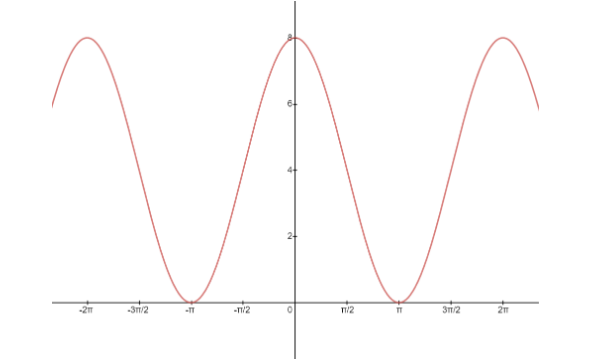
How do you graph \[y = 4\cos x + 4\] ?
Answer
532.8k+ views
Hint: We are given a function of cosine and we have to plot this function on the graph. We have to first convert the given function to its standard form and then compare it with the standard equation for plotting any function on the graph, this way we can find out how the graph of the given function should be plotted. The standard form of the cosine equation is $y = A\cos (Bx + C) + D$ .
Complete step-by-step answer:
On comparing \[y = 4\cos x + 4\] with the standard form $y = A\cos (Bx + C) + D$ , we get –
$A = 4,\,B = 1,\,C = 0\,and\,D = 4$
Thus, the given cosine function has a vertical shift of 4, so it has peak values at -4+4 and 4+4, that is, it oscillates between 0 and 8 and the given cosine function completes one oscillations between 0 and $2\pi $ , but for plotting the graph, we have to find out the period of the function. Period of this cosine function is –
$
p = \dfrac{{2\pi }}{B} \\
\Rightarrow p = \dfrac{{2\pi }}{1} = 2\pi \;
$
That is after every $2\pi $ radians the given function repeats the oscillation; it completes 1 oscillation in the interval 0 to $2\pi $ .

Note: We know that the general form of the cosine function is $y = A\cos (Bx + C) + D$ where
A is the amplitude, the peak values of a function are known as its amplitude.
B is the frequency, the number of oscillations that a function does in a fixed interval is known as its frequency.
C and D tell us the horizontal and vertical shift of a function respectively. There is no horizontal or vertical shift in the given function as the value of C and D is zero for the given function.
Complete step-by-step answer:
On comparing \[y = 4\cos x + 4\] with the standard form $y = A\cos (Bx + C) + D$ , we get –
$A = 4,\,B = 1,\,C = 0\,and\,D = 4$
Thus, the given cosine function has a vertical shift of 4, so it has peak values at -4+4 and 4+4, that is, it oscillates between 0 and 8 and the given cosine function completes one oscillations between 0 and $2\pi $ , but for plotting the graph, we have to find out the period of the function. Period of this cosine function is –
$
p = \dfrac{{2\pi }}{B} \\
\Rightarrow p = \dfrac{{2\pi }}{1} = 2\pi \;
$
That is after every $2\pi $ radians the given function repeats the oscillation; it completes 1 oscillation in the interval 0 to $2\pi $ .

Note: We know that the general form of the cosine function is $y = A\cos (Bx + C) + D$ where
A is the amplitude, the peak values of a function are known as its amplitude.
B is the frequency, the number of oscillations that a function does in a fixed interval is known as its frequency.
C and D tell us the horizontal and vertical shift of a function respectively. There is no horizontal or vertical shift in the given function as the value of C and D is zero for the given function.
Recently Updated Pages
Master Class 11 Economics: Engaging Questions & Answers for Success

Master Class 11 English: Engaging Questions & Answers for Success

Master Class 11 Social Science: Engaging Questions & Answers for Success

Master Class 11 Biology: Engaging Questions & Answers for Success

Class 11 Question and Answer - Your Ultimate Solutions Guide

Master Class 11 Business Studies: Engaging Questions & Answers for Success

Trending doubts
What is meant by exothermic and endothermic reactions class 11 chemistry CBSE

10 examples of friction in our daily life

One Metric ton is equal to kg A 10000 B 1000 C 100 class 11 physics CBSE

Difference Between Prokaryotic Cells and Eukaryotic Cells

What are Quantum numbers Explain the quantum number class 11 chemistry CBSE

1 Quintal is equal to a 110 kg b 10 kg c 100kg d 1000 class 11 physics CBSE




